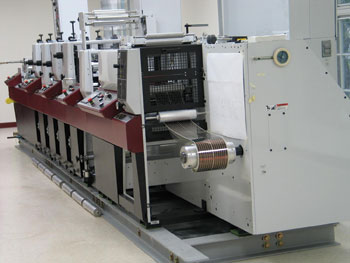The next generation of solar cells lends itself to high-speed roll-to-roll processing.
Russell Gaudiana, Konarka Technologies Inc.
Photovoltaics based on crystalline silicon dominate the commercial solar energy industry; however, because solar energy is competing with energy sources such as gas and coal, the quest for new photovoltaic materials has expanded.
Any new energy source must fulfill three requirements: It must use abundant nontoxic materials, it must be produced in a scalable process with high productivity, and the production process must require low capital investment.
Roll-to-roll coating and printing has been identified as the most promising production process. In the late 1980s and early 1990s, fundamentally new material approaches to solution processing of low-cost photovoltaics emerged — namely, the bulk heterojunction active layer. A bulk heterojunction is a two-phase blend of p- and n-type semiconductors that has a very large surface area. Upon light absorption, photoinduced charges are produced via an ultrafast charge transfer (a few femtoseconds) between the two semiconductor types. Multiple material systems have been suggested for bulk heterojunction solar cells, including organic semiconductors, inorganic and organic semiconductor nanoparticles and nanorods, and combinations of these.
Organic photovoltaics
Among these technology platforms, organic photovoltaics, a technology comprising carbon-based polymers, is one of the most attractive. The feature that differentiates it from all of the others is that it can be used in high-speed, low-temperature roll-to-roll manufacturing. The processes are typical of those used in the printing and coating industry in that solutions of the active materials, dissolved in organic solvents, are applied to a plastic sheet by means of a coating applicator.
Various printing and coating technologies have proved their utility to organic semiconductor processing (Figure 1). Among them are gravure printing, flexo printing, screen printing, slot die coating and, most recently, ink-jet printing.

Figure 1. Organic photovoltaics are produced on a printing press.
The printing solvent is evaporated when heated to moderate temperatures — for example, <120 °C — producing dried active layers of the blend as well as charge transport layers. Layer thickness for all of these is in the 100- to 200-nm range and requires a precision coating operation in a well-controlled environment. The layers are encapsulated between thin flexible overlaminates that protect them from mechanical abrasion and from the environment.
Capital costs are low, and the printing/coating processes can be carried out at speeds of up to 30 to 40 m/min using substrates as wide as 2 m. The combination of low-temperature processing and high throughput will result in high production rates. Although no complete life cycle analysis has been made, rooftop stability of plastic modules is more than a year. At large volumes and at reasonable efficiencies beyond 5 percent and up to 10 percent, these printed solar cells could cost significantly less than $1/W peak (power at peak or one sun is equal to noon on the equator) to produce.
Significant improvements in performance will center primarily on the development of new photoactive materials to be used for the bulk heterojunction. Currently, the polymers used in this layer absorb only about 40 percent of the available solar radiation, which affects light harvesting and current generation. Besides, optimizing the energy level between the two components of this layer will generate a significant increase in cell voltage. When combined, these advances will significantly improve the power generation of the modules.
Organic photovoltaic modules offer a unique combination of properties, including light weight, flexibility, low cost and a high power-to-weight ratio — for example, >100 mW/g at 5 percent efficiency. This makes the devices particularly useful for portable applications, which represent the first target market for this technology and include battery chargers for cell phones, laptops, global positioning systems, radios, flashlights, toys and virtually any handheld device that uses a battery (Figure 2).

Figure 2. In the near future, thin flexible solar modules made from multicell coatings will be integrated into clothing, portable electronics, building materials and other innovative applications.
The modules can be adhered to the outside face of a briefcase or to a piece of clothing, or they can be incorporated into a device’s housing. They also can be rolled up or folded for storage in a pocket or case when not in use. The first products serving this market should be available early next year. Building integrated applications such as awnings, shades and blinds, and even windows themselves will create additional commercial opportunities for this technology.
Meet the author
Russell Gaudiana is vice president of research at Konarka Technologies in Lowell, Mass.; e-mail: [email protected].